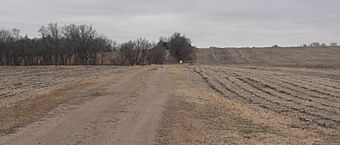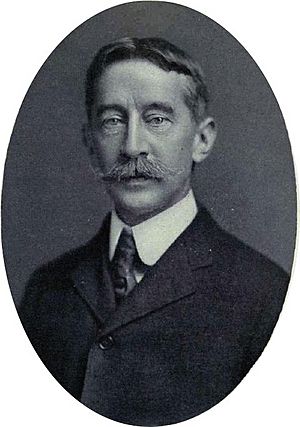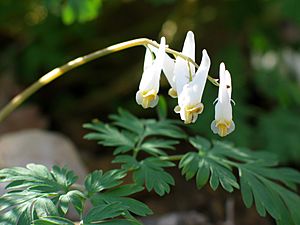Pahuk facts for kids
Quick facts for kids |
|
|
Pahuk
|
|

Pahuk, seen from the south
|
|
| Lua error in Module:Location_map at line 420: attempt to index field 'wikibase' (a nil value). | |
| Nearest city | Cedar Bluffs, Nebraska |
|---|---|
| Area | 85 acres (34 ha) |
| NRHP reference No. | 73001074 |
| Added to NRHP | August 14, 1973 |
Pahuk, also known as Pahaku or Pahuk Hill, is a tall cliff along the Platte River in eastern Nebraska, United States. For the traditional Pawnee people, Pahuk was a very special place. It was believed to be one of five homes for powerful spirit animals. Before the Pawnee moved to a new reservation in 1859, they lived in three villages close to Pahuk.
Today, Pahuk is recognized as an important historical site and is listed on the National Register of Historic Places.
What is Pahuk?
Pahuk is a bluff, which is a steep cliff, formed by the Platte River and smaller streams. The side facing the river is almost straight up, rising about 150 feet (46 meters) from the water. On its east and west sides, there are deep, steep valleys about 1,000 feet (305 meters) apart. The land gently slopes down to the south. There's a small rise about 40 feet (12 meters) high near the edge of the bluff, making Pahuk the highest spot for many miles around.
Pawnee Traditions and Beliefs
The name "Pahuk" comes from the Pawnee language. It usually means "hill island." The Pawnee people also sometimes call it "Pahaku."
In the traditional Pawnee religion, the main god, Tirawa, gave special powers to certain animals. These powerful spirit animals are called nahurac. They act as messengers and helpers for Tirawa. They can also speak to Tirawa for the Pawnee people.
The nahurac were believed to have five secret underground homes. Pahuk was one of these important places. The other four homes were:
- Lalawakohtito, or "dark island," which was an island in the Platte River.
- Ahkawitakol, or "white bank," located on the Loup River.
- Pahur, or "hill that points the way," a bluff near Guide Rock, Nebraska.
- Kitzawitzuk, or "water on a bank," a spring known today as Waconda Spring in Kansas.
The nahurac who gathered at Pahuk were thought to be the most powerful of all. They appear in many Pawnee stories. For example, in a tale called "A Story of Faith," a young healer gets sick from a rival. He wanders until he finds Pahuk. The animal healers there send him to the other four nahurac homes. But none of them can cure him. They all agree that the healers at Pahuk are the most powerful. The man is then brought back to Pahuk, where the animal healers cure him and teach him their secrets.
Another Pawnee story tells that the first people and animals woke up from sleeping underground. They came out onto the Earth's surface through a hole right on Pahuk.
History of Pahuk
In the 1850s, three Pawnee villages were located near Pahuk. The Skidi (Wolf Pawnee) built a village on the bluff between 1847 and 1850. By 1855, the Pitahauerats (Tapage Pawnee) joined them. This village was protected by a sod wall to defend against attacks from the Sioux tribe. The Chaui (Grand Pawnee) lived in a village about four miles southeast. A third village, likely of the Kitkehahki (Republican Pawnee), was on the south side of the Platte River.
In 1857, the Pawnee signed a treaty. They were under pressure from white settlers and Sioux attacks. They agreed to give up their land in Nebraska in exchange for a reservation on the Loup River. In 1859, the Pawnee left their villages near Pahuk for their summer buffalo hunt. Soon after they left, the villages were burned. This was done either by Sioux raiders or by settlers. The destruction of their homes and the hope of government protection from the Sioux led the Pawnee to move to the reservation.
In 1858, the Nebraska Territorial Legislature tried to move the capital from Omaha to Pahuk. They called Pahuk "Capitol Hill" and planned to build a new city there called Neapolis. However, the governor did not approve this move. So, the new community of Neapolis was soon abandoned.
Pahuk was claimed by settlers in 1868 under the Homestead Acts. The name "Pohocco Precinct" was given to a nearby area in 1869, even though Pahuk itself was not inside that area.
Protecting Pahuk
Even though the top of the bluff was used for farming, the site itself remained mostly untouched. In 1962, Dr. Louis and Geraldine Gilbert bought the wooded part of the bluff. When they learned how important it was to the Pawnee people, they worked to have it listed on the National Register of Historic Places. This was approved in 1973. By then, Pahuk was the only one of the five nahurac sites that had not been destroyed or badly damaged.
In the 1980s, the Gilberts put a conservation easement on their land. This means the land is protected from development. Because of this protection and Pahuk's sacred meaning to the Pawnee, the Nebraska Department of Roads decided in 2005 not to build a new highway near it.
In 2008, Pat and Nancy Shanahan, who farmed the land on top of the bluff, also created a conservation easement. This protected their 257 acres (104 hectares) from being developed. Four representatives from the Pawnee tribe traveled from Oklahoma to Nebraska for the special ceremony.
Besides its historical and religious importance, Pahuk is also interesting to scientists who study plants and animals. It is one of the westernmost places in the Platte Valley where certain eastern woodland plants grow. These include bitternut hickory, black walnut, American linden, and Dutchman's breeches.



